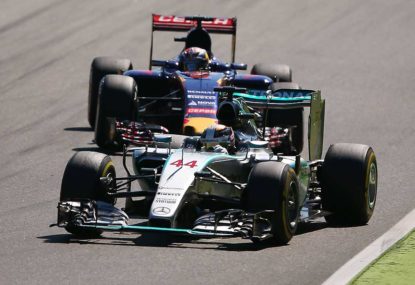Supercars Perth SuperSprint Talking Points: Breakthrough wins for two distinguished drivers as a rookie impressed
Chaz Mostert and Cameron Waters broke through for their first wins of the 2024 season.

Formula One’s Strategy Group’s plans to increase overtaking as part of a post 2017 category revamp have looked to the 1980s for inspiration by increasing down-force, introducing wider rear tyres and cranking up engine – sorry power-train – output to 1,000 horsepower.
In keeping with this theme, another idea slapped on the table is a return of ground effects. The major advantage is that down-force is created along the entire length of the floor and thus less reliant on its front-wing.
This theoretically eliminates the issue of drivers getting caught up in turbulent air while following another car, losing overall down-force and being unable to keep pace – let alone execute a pass.
So how far down the road has the Strategy Group progressed with the idea?
“All I can say is the design we have on the table [for 2017] is not necessarily something that would cover that,” admitted Force India technical director Andrew Green.
In a constantly-evolving category like Formula One, the ground effect route would be considered to be a retrograde step. A healthy compromise however, has already been developed courtesy of Japan’s premier open-wheeler category, Super Formula.
After reviewing its inaugural season, Super Formula introduced a new chassis from 2014 (the SF14). The design brief for the SF14 was that it had to be very quick and light. The predecessor, the SF14 (or Formula Nippon SN09) was very heavy with high levels of down-force, but as such had a large turbulent effect on cars travelling in its wake.
The car offered sufficient aerodynamic down-force from low-speed to high-speed corners, but in an effort to boost racing, series’ chassis provider Dallara and Japanese Manufacturing Promoters (JRP) decided a new car with a smaller range of trailing turbulence was required.
The trick was designing the end-plates of the rear wing to direct dirty air from both sides of the diffuser, thereby creating a smaller turbulent area behind the car.
At the same time, the front wing was conceived from extensive analysis from GP2 cars; the important ingredient being that the main aerofoil is placed on the outer side of the wing with the centre being quite neutral.
What this means for a driver is that they have a much larger window of operation when travelling behind a competitor and doesn’t lose a huge amount of down-force before attempting a passing move. The snake-train this creates is very much like Formula Ford, but with wings and slicks.
Super Formula receives major manufacturer support from Toyota and Honda with teams powered by four cylinder, two-litre turbo engines. The turbocharged four-cylinder direct injection units will produce around 550bhp and have a 50bhp boost function.
The Overtake System (OTS) works by leveraging the fuel flow restrictor (fuel flow rate control system) employed on the new engine. It can increase fuel supply temporarily to provide approximately five per cent of engine performance improvement.
Initially the boost was thought to be deployed via a hybrid system.
Intriguingly, the rev-limiter mantain a maximum of 10,300 rpm and help ensure that performance does not exceed a prescribed level – so that it is eventually the technique of the drivers that decides the outcome of the race. This also serves to limit engine wear and thus reduce maintenance cost.
According to AutoSprint, Rumours are that Honda plan to install their current Formula One V6 unit to a current SF14 chassis and test it at Suzuka, possibly in collaboration with either the Mugen or Nakajima teams.
While any undertaking would be to underline the potential of the Honda power unit in comparison to the McLaren chassis, the data gained could be a godsend to the current Formula One Strategy Group in deciding which way to go forward.
A series at the forefront of automotive technology while retaining the hallmarks of what makes great racing… Sounds too simple, doesn’t it?